Comprehensive Analysis of Tourism Policies: A Case Study of TIABC
VerifiedAdded on 2022/09/22
|6
|1629
|23
Report
AI Summary
This report analyzes tourism policies, specifically focusing on the recommendations made by the Tourism Industry Association of British Columbia (TIABC). The report examines the legal and regulatory instruments used by TIABC to address issues such as the elimination of the PST and MRDT exemptions, and how these policies aim to improve the well-being of the community. The report further discusses the advantages and disadvantages of implementing policies at the provincial versus municipal levels, considering factors like flexibility, equity, and cost-effectiveness. Finally, the report explores solutions to the lack of affordable accommodation in the tourism sector, including the impact of minimum wage increases and the role of government incentives such as subsidies and land provisions. The analysis highlights how these policies can contribute to economic growth and improve the living standards of workers in the tourism industry.
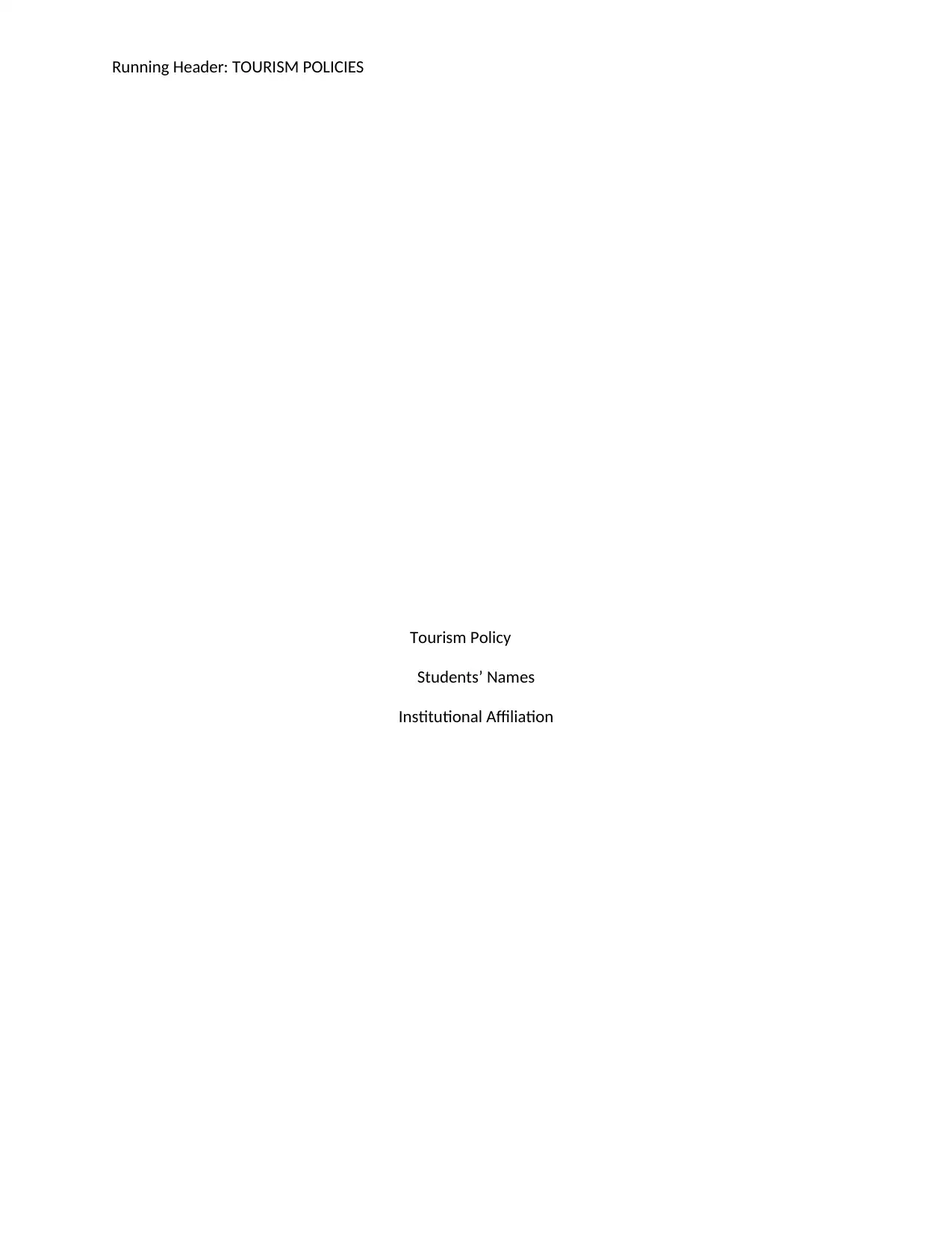
Running Header: TOURISM POLICIES
Tourism Policy
Students’ Names
Institutional Affiliation
Tourism Policy
Students’ Names
Institutional Affiliation
Paraphrase This Document
Need a fresh take? Get an instant paraphrase of this document with our AI Paraphraser
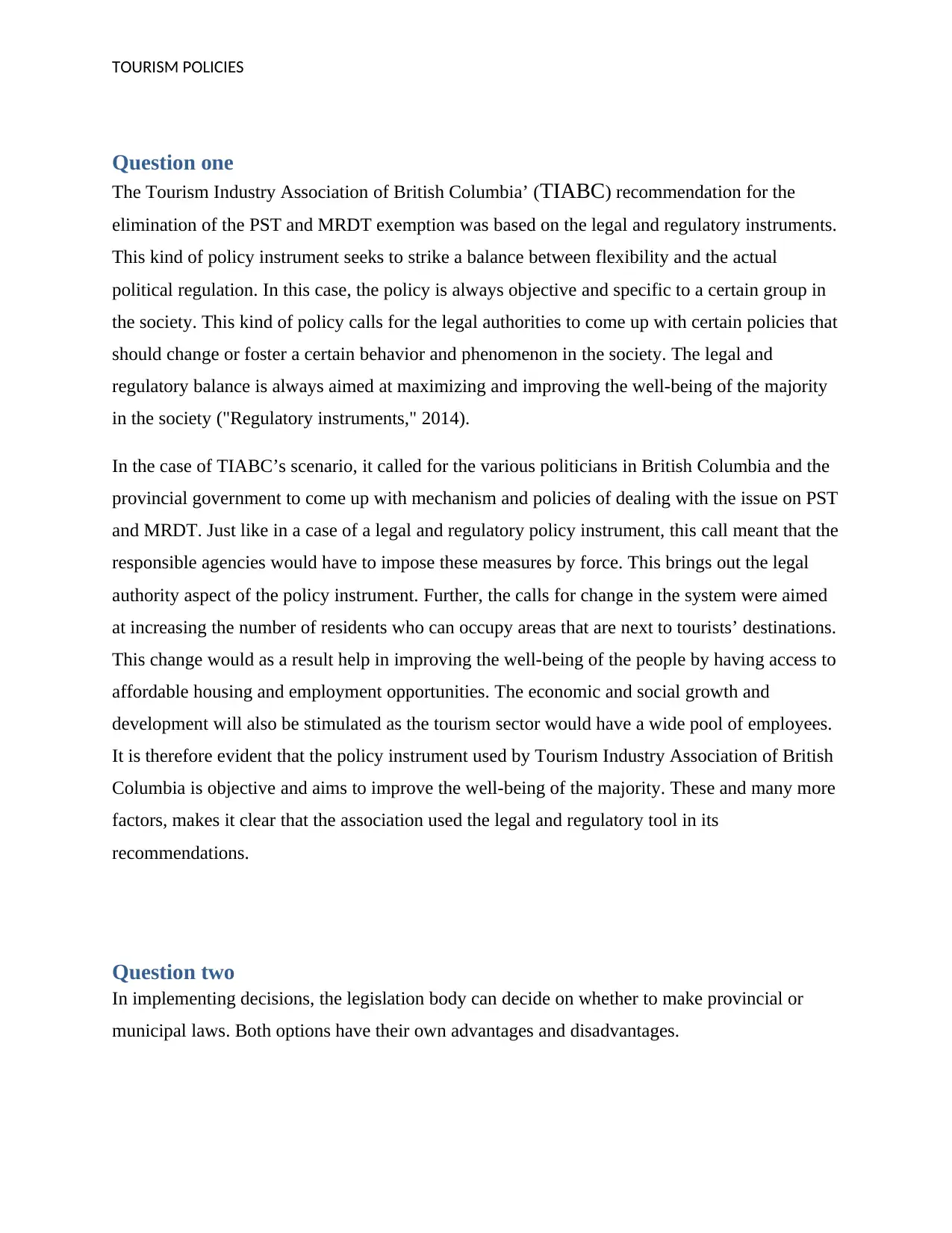
TOURISM POLICIES
Question one
The Tourism Industry Association of British Columbia’ (TIABC) recommendation for the
elimination of the PST and MRDT exemption was based on the legal and regulatory instruments.
This kind of policy instrument seeks to strike a balance between flexibility and the actual
political regulation. In this case, the policy is always objective and specific to a certain group in
the society. This kind of policy calls for the legal authorities to come up with certain policies that
should change or foster a certain behavior and phenomenon in the society. The legal and
regulatory balance is always aimed at maximizing and improving the well-being of the majority
in the society ("Regulatory instruments," 2014).
In the case of TIABC’s scenario, it called for the various politicians in British Columbia and the
provincial government to come up with mechanism and policies of dealing with the issue on PST
and MRDT. Just like in a case of a legal and regulatory policy instrument, this call meant that the
responsible agencies would have to impose these measures by force. This brings out the legal
authority aspect of the policy instrument. Further, the calls for change in the system were aimed
at increasing the number of residents who can occupy areas that are next to tourists’ destinations.
This change would as a result help in improving the well-being of the people by having access to
affordable housing and employment opportunities. The economic and social growth and
development will also be stimulated as the tourism sector would have a wide pool of employees.
It is therefore evident that the policy instrument used by Tourism Industry Association of British
Columbia is objective and aims to improve the well-being of the majority. These and many more
factors, makes it clear that the association used the legal and regulatory tool in its
recommendations.
Question two
In implementing decisions, the legislation body can decide on whether to make provincial or
municipal laws. Both options have their own advantages and disadvantages.
Question one
The Tourism Industry Association of British Columbia’ (TIABC) recommendation for the
elimination of the PST and MRDT exemption was based on the legal and regulatory instruments.
This kind of policy instrument seeks to strike a balance between flexibility and the actual
political regulation. In this case, the policy is always objective and specific to a certain group in
the society. This kind of policy calls for the legal authorities to come up with certain policies that
should change or foster a certain behavior and phenomenon in the society. The legal and
regulatory balance is always aimed at maximizing and improving the well-being of the majority
in the society ("Regulatory instruments," 2014).
In the case of TIABC’s scenario, it called for the various politicians in British Columbia and the
provincial government to come up with mechanism and policies of dealing with the issue on PST
and MRDT. Just like in a case of a legal and regulatory policy instrument, this call meant that the
responsible agencies would have to impose these measures by force. This brings out the legal
authority aspect of the policy instrument. Further, the calls for change in the system were aimed
at increasing the number of residents who can occupy areas that are next to tourists’ destinations.
This change would as a result help in improving the well-being of the people by having access to
affordable housing and employment opportunities. The economic and social growth and
development will also be stimulated as the tourism sector would have a wide pool of employees.
It is therefore evident that the policy instrument used by Tourism Industry Association of British
Columbia is objective and aims to improve the well-being of the majority. These and many more
factors, makes it clear that the association used the legal and regulatory tool in its
recommendations.
Question two
In implementing decisions, the legislation body can decide on whether to make provincial or
municipal laws. Both options have their own advantages and disadvantages.
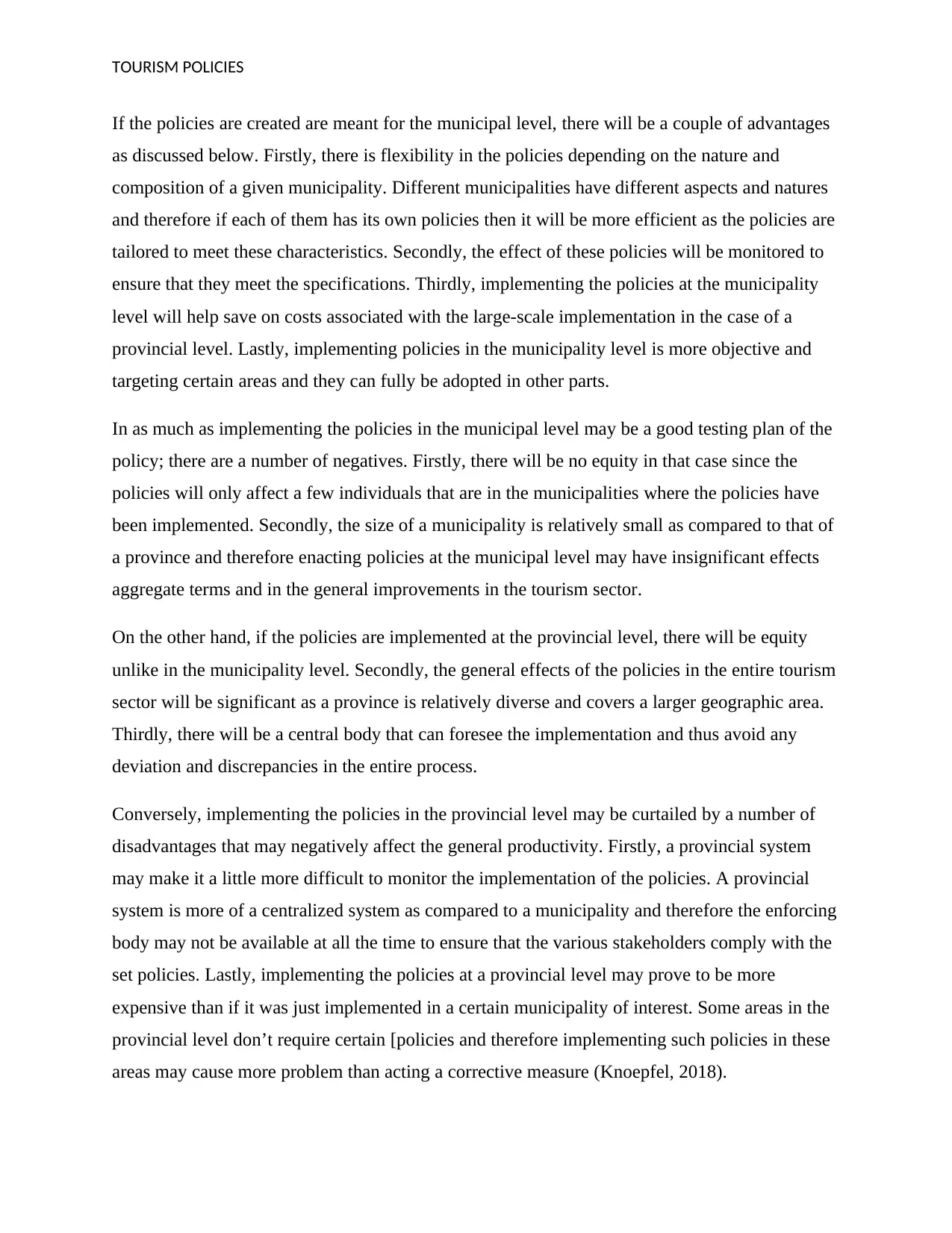
TOURISM POLICIES
If the policies are created are meant for the municipal level, there will be a couple of advantages
as discussed below. Firstly, there is flexibility in the policies depending on the nature and
composition of a given municipality. Different municipalities have different aspects and natures
and therefore if each of them has its own policies then it will be more efficient as the policies are
tailored to meet these characteristics. Secondly, the effect of these policies will be monitored to
ensure that they meet the specifications. Thirdly, implementing the policies at the municipality
level will help save on costs associated with the large-scale implementation in the case of a
provincial level. Lastly, implementing policies in the municipality level is more objective and
targeting certain areas and they can fully be adopted in other parts.
In as much as implementing the policies in the municipal level may be a good testing plan of the
policy; there are a number of negatives. Firstly, there will be no equity in that case since the
policies will only affect a few individuals that are in the municipalities where the policies have
been implemented. Secondly, the size of a municipality is relatively small as compared to that of
a province and therefore enacting policies at the municipal level may have insignificant effects
aggregate terms and in the general improvements in the tourism sector.
On the other hand, if the policies are implemented at the provincial level, there will be equity
unlike in the municipality level. Secondly, the general effects of the policies in the entire tourism
sector will be significant as a province is relatively diverse and covers a larger geographic area.
Thirdly, there will be a central body that can foresee the implementation and thus avoid any
deviation and discrepancies in the entire process.
Conversely, implementing the policies in the provincial level may be curtailed by a number of
disadvantages that may negatively affect the general productivity. Firstly, a provincial system
may make it a little more difficult to monitor the implementation of the policies. A provincial
system is more of a centralized system as compared to a municipality and therefore the enforcing
body may not be available at all the time to ensure that the various stakeholders comply with the
set policies. Lastly, implementing the policies at a provincial level may prove to be more
expensive than if it was just implemented in a certain municipality of interest. Some areas in the
provincial level don’t require certain [policies and therefore implementing such policies in these
areas may cause more problem than acting a corrective measure (Knoepfel, 2018).
If the policies are created are meant for the municipal level, there will be a couple of advantages
as discussed below. Firstly, there is flexibility in the policies depending on the nature and
composition of a given municipality. Different municipalities have different aspects and natures
and therefore if each of them has its own policies then it will be more efficient as the policies are
tailored to meet these characteristics. Secondly, the effect of these policies will be monitored to
ensure that they meet the specifications. Thirdly, implementing the policies at the municipality
level will help save on costs associated with the large-scale implementation in the case of a
provincial level. Lastly, implementing policies in the municipality level is more objective and
targeting certain areas and they can fully be adopted in other parts.
In as much as implementing the policies in the municipal level may be a good testing plan of the
policy; there are a number of negatives. Firstly, there will be no equity in that case since the
policies will only affect a few individuals that are in the municipalities where the policies have
been implemented. Secondly, the size of a municipality is relatively small as compared to that of
a province and therefore enacting policies at the municipal level may have insignificant effects
aggregate terms and in the general improvements in the tourism sector.
On the other hand, if the policies are implemented at the provincial level, there will be equity
unlike in the municipality level. Secondly, the general effects of the policies in the entire tourism
sector will be significant as a province is relatively diverse and covers a larger geographic area.
Thirdly, there will be a central body that can foresee the implementation and thus avoid any
deviation and discrepancies in the entire process.
Conversely, implementing the policies in the provincial level may be curtailed by a number of
disadvantages that may negatively affect the general productivity. Firstly, a provincial system
may make it a little more difficult to monitor the implementation of the policies. A provincial
system is more of a centralized system as compared to a municipality and therefore the enforcing
body may not be available at all the time to ensure that the various stakeholders comply with the
set policies. Lastly, implementing the policies at a provincial level may prove to be more
expensive than if it was just implemented in a certain municipality of interest. Some areas in the
provincial level don’t require certain [policies and therefore implementing such policies in these
areas may cause more problem than acting a corrective measure (Knoepfel, 2018).
⊘ This is a preview!⊘
Do you want full access?
Subscribe today to unlock all pages.

Trusted by 1+ million students worldwide
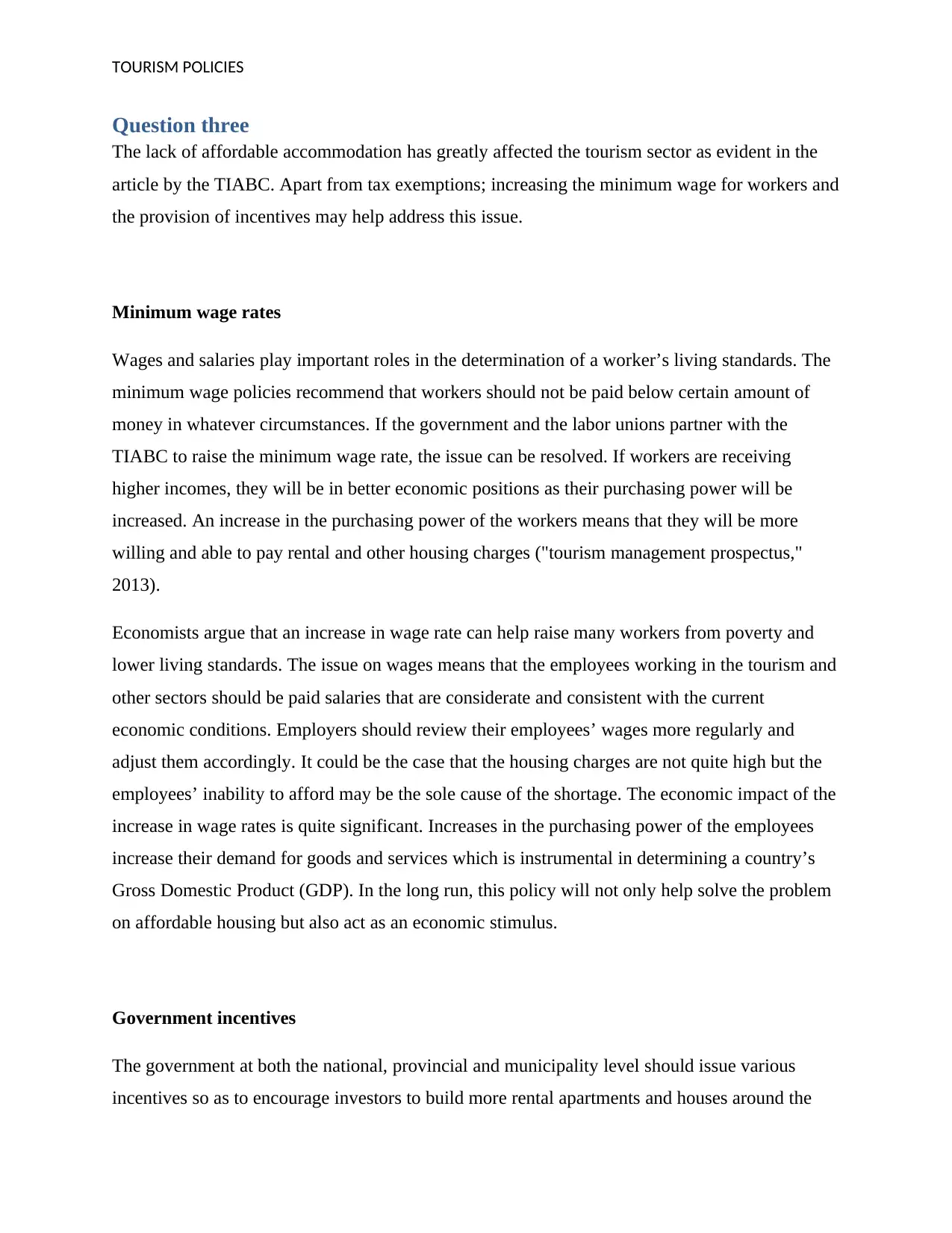
TOURISM POLICIES
Question three
The lack of affordable accommodation has greatly affected the tourism sector as evident in the
article by the TIABC. Apart from tax exemptions; increasing the minimum wage for workers and
the provision of incentives may help address this issue.
Minimum wage rates
Wages and salaries play important roles in the determination of a worker’s living standards. The
minimum wage policies recommend that workers should not be paid below certain amount of
money in whatever circumstances. If the government and the labor unions partner with the
TIABC to raise the minimum wage rate, the issue can be resolved. If workers are receiving
higher incomes, they will be in better economic positions as their purchasing power will be
increased. An increase in the purchasing power of the workers means that they will be more
willing and able to pay rental and other housing charges ("tourism management prospectus,"
2013).
Economists argue that an increase in wage rate can help raise many workers from poverty and
lower living standards. The issue on wages means that the employees working in the tourism and
other sectors should be paid salaries that are considerate and consistent with the current
economic conditions. Employers should review their employees’ wages more regularly and
adjust them accordingly. It could be the case that the housing charges are not quite high but the
employees’ inability to afford may be the sole cause of the shortage. The economic impact of the
increase in wage rates is quite significant. Increases in the purchasing power of the employees
increase their demand for goods and services which is instrumental in determining a country’s
Gross Domestic Product (GDP). In the long run, this policy will not only help solve the problem
on affordable housing but also act as an economic stimulus.
Government incentives
The government at both the national, provincial and municipality level should issue various
incentives so as to encourage investors to build more rental apartments and houses around the
Question three
The lack of affordable accommodation has greatly affected the tourism sector as evident in the
article by the TIABC. Apart from tax exemptions; increasing the minimum wage for workers and
the provision of incentives may help address this issue.
Minimum wage rates
Wages and salaries play important roles in the determination of a worker’s living standards. The
minimum wage policies recommend that workers should not be paid below certain amount of
money in whatever circumstances. If the government and the labor unions partner with the
TIABC to raise the minimum wage rate, the issue can be resolved. If workers are receiving
higher incomes, they will be in better economic positions as their purchasing power will be
increased. An increase in the purchasing power of the workers means that they will be more
willing and able to pay rental and other housing charges ("tourism management prospectus,"
2013).
Economists argue that an increase in wage rate can help raise many workers from poverty and
lower living standards. The issue on wages means that the employees working in the tourism and
other sectors should be paid salaries that are considerate and consistent with the current
economic conditions. Employers should review their employees’ wages more regularly and
adjust them accordingly. It could be the case that the housing charges are not quite high but the
employees’ inability to afford may be the sole cause of the shortage. The economic impact of the
increase in wage rates is quite significant. Increases in the purchasing power of the employees
increase their demand for goods and services which is instrumental in determining a country’s
Gross Domestic Product (GDP). In the long run, this policy will not only help solve the problem
on affordable housing but also act as an economic stimulus.
Government incentives
The government at both the national, provincial and municipality level should issue various
incentives so as to encourage investors to build more rental apartments and houses around the
Paraphrase This Document
Need a fresh take? Get an instant paraphrase of this document with our AI Paraphraser
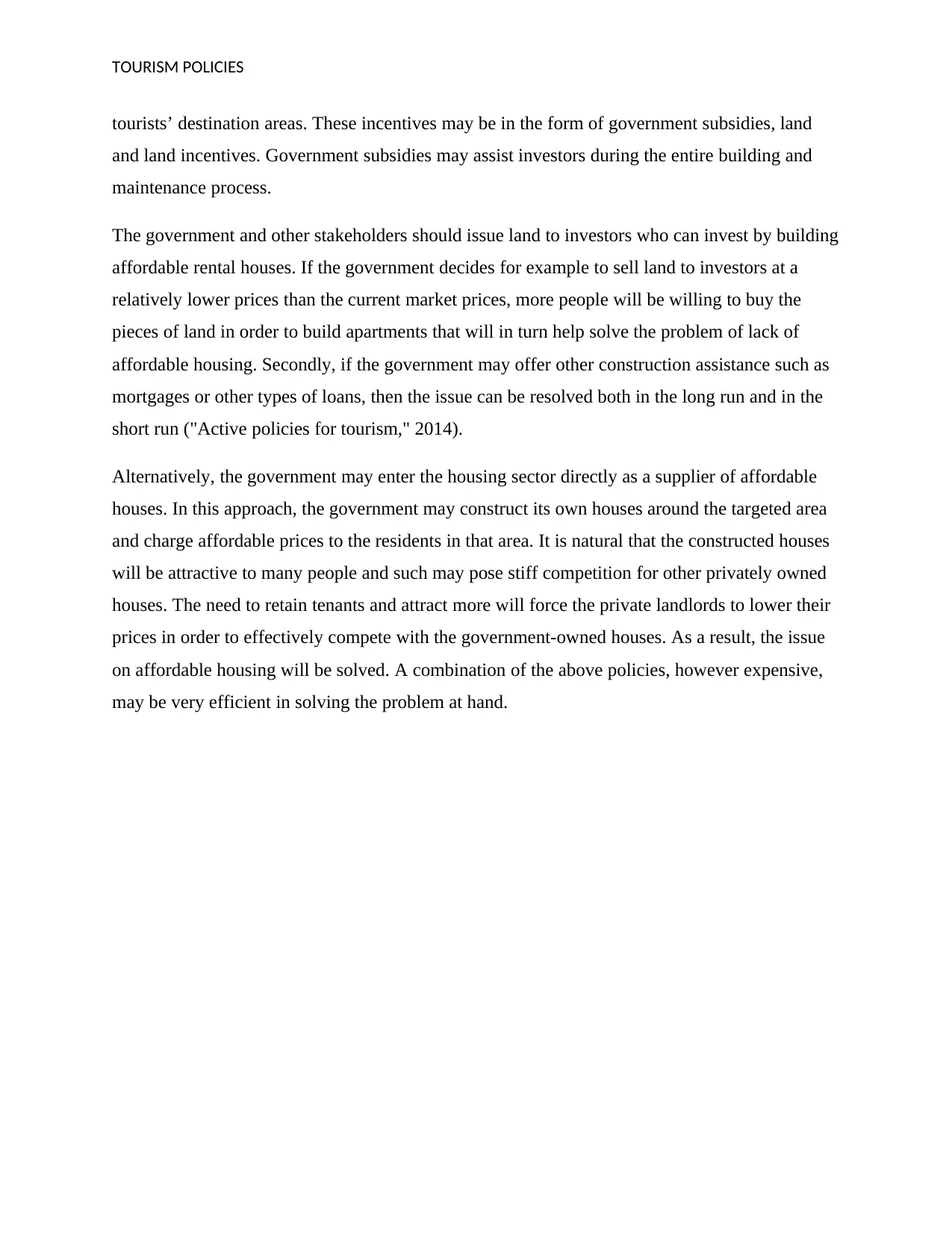
TOURISM POLICIES
tourists’ destination areas. These incentives may be in the form of government subsidies, land
and land incentives. Government subsidies may assist investors during the entire building and
maintenance process.
The government and other stakeholders should issue land to investors who can invest by building
affordable rental houses. If the government decides for example to sell land to investors at a
relatively lower prices than the current market prices, more people will be willing to buy the
pieces of land in order to build apartments that will in turn help solve the problem of lack of
affordable housing. Secondly, if the government may offer other construction assistance such as
mortgages or other types of loans, then the issue can be resolved both in the long run and in the
short run ("Active policies for tourism," 2014).
Alternatively, the government may enter the housing sector directly as a supplier of affordable
houses. In this approach, the government may construct its own houses around the targeted area
and charge affordable prices to the residents in that area. It is natural that the constructed houses
will be attractive to many people and such may pose stiff competition for other privately owned
houses. The need to retain tenants and attract more will force the private landlords to lower their
prices in order to effectively compete with the government-owned houses. As a result, the issue
on affordable housing will be solved. A combination of the above policies, however expensive,
may be very efficient in solving the problem at hand.
tourists’ destination areas. These incentives may be in the form of government subsidies, land
and land incentives. Government subsidies may assist investors during the entire building and
maintenance process.
The government and other stakeholders should issue land to investors who can invest by building
affordable rental houses. If the government decides for example to sell land to investors at a
relatively lower prices than the current market prices, more people will be willing to buy the
pieces of land in order to build apartments that will in turn help solve the problem of lack of
affordable housing. Secondly, if the government may offer other construction assistance such as
mortgages or other types of loans, then the issue can be resolved both in the long run and in the
short run ("Active policies for tourism," 2014).
Alternatively, the government may enter the housing sector directly as a supplier of affordable
houses. In this approach, the government may construct its own houses around the targeted area
and charge affordable prices to the residents in that area. It is natural that the constructed houses
will be attractive to many people and such may pose stiff competition for other privately owned
houses. The need to retain tenants and attract more will force the private landlords to lower their
prices in order to effectively compete with the government-owned houses. As a result, the issue
on affordable housing will be solved. A combination of the above policies, however expensive,
may be very efficient in solving the problem at hand.
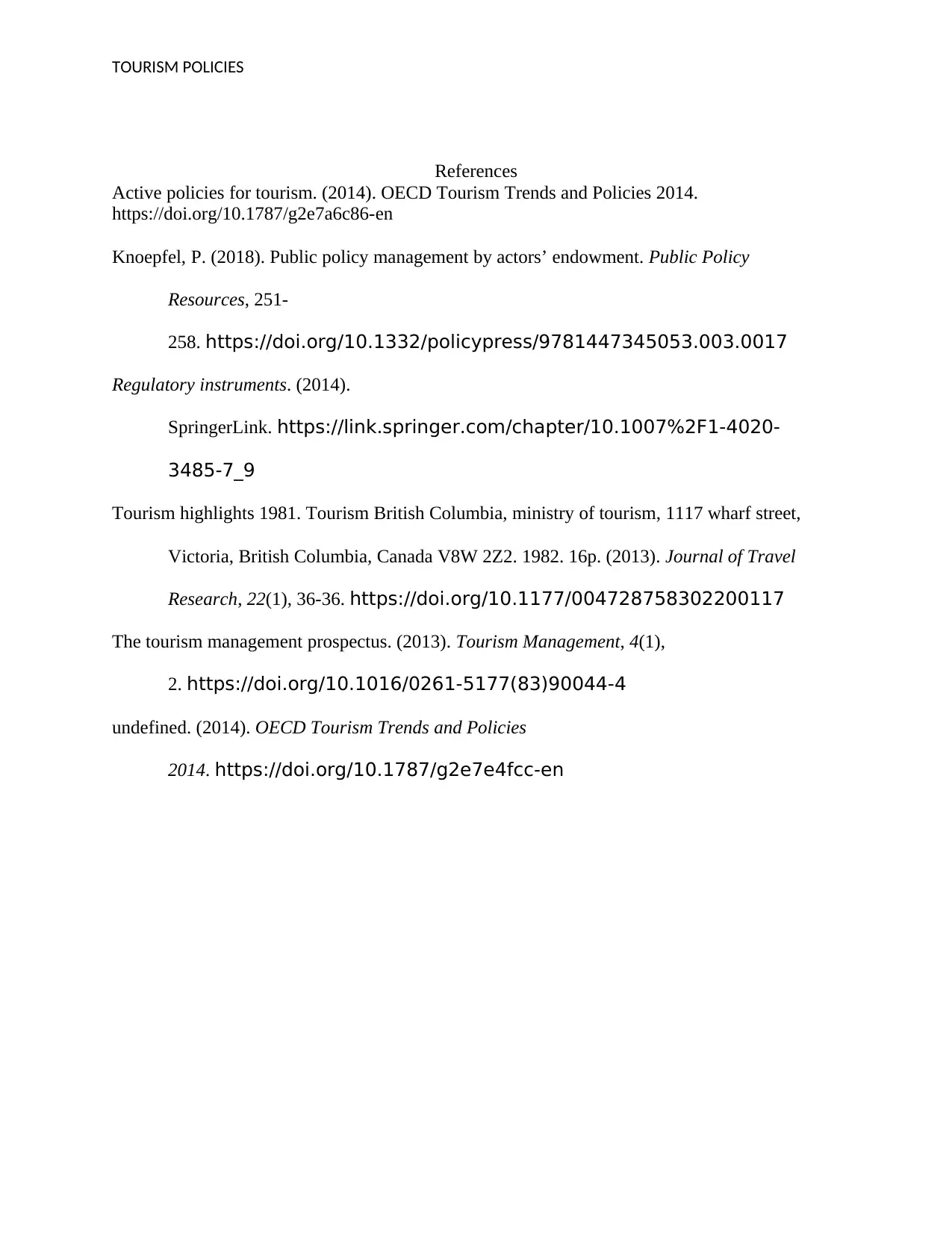
TOURISM POLICIES
References
Active policies for tourism. (2014). OECD Tourism Trends and Policies 2014.
https://doi.org/10.1787/g2e7a6c86-en
Knoepfel, P. (2018). Public policy management by actors’ endowment. Public Policy
Resources, 251-
258. https://doi.org/10.1332/policypress/9781447345053.003.0017
Regulatory instruments. (2014).
SpringerLink. https://link.springer.com/chapter/10.1007%2F1-4020-
3485-7_9
Tourism highlights 1981. Tourism British Columbia, ministry of tourism, 1117 wharf street,
Victoria, British Columbia, Canada V8W 2Z2. 1982. 16p. (2013). Journal of Travel
Research, 22(1), 36-36. https://doi.org/10.1177/004728758302200117
The tourism management prospectus. (2013). Tourism Management, 4(1),
2. https://doi.org/10.1016/0261-5177(83)90044-4
undefined. (2014). OECD Tourism Trends and Policies
2014. https://doi.org/10.1787/g2e7e4fcc-en
References
Active policies for tourism. (2014). OECD Tourism Trends and Policies 2014.
https://doi.org/10.1787/g2e7a6c86-en
Knoepfel, P. (2018). Public policy management by actors’ endowment. Public Policy
Resources, 251-
258. https://doi.org/10.1332/policypress/9781447345053.003.0017
Regulatory instruments. (2014).
SpringerLink. https://link.springer.com/chapter/10.1007%2F1-4020-
3485-7_9
Tourism highlights 1981. Tourism British Columbia, ministry of tourism, 1117 wharf street,
Victoria, British Columbia, Canada V8W 2Z2. 1982. 16p. (2013). Journal of Travel
Research, 22(1), 36-36. https://doi.org/10.1177/004728758302200117
The tourism management prospectus. (2013). Tourism Management, 4(1),
2. https://doi.org/10.1016/0261-5177(83)90044-4
undefined. (2014). OECD Tourism Trends and Policies
2014. https://doi.org/10.1787/g2e7e4fcc-en
⊘ This is a preview!⊘
Do you want full access?
Subscribe today to unlock all pages.

Trusted by 1+ million students worldwide
1 out of 6
Related Documents
Your All-in-One AI-Powered Toolkit for Academic Success.
+13062052269
info@desklib.com
Available 24*7 on WhatsApp / Email
![[object Object]](/_next/static/media/star-bottom.7253800d.svg)
Unlock your academic potential
Copyright © 2020–2025 A2Z Services. All Rights Reserved. Developed and managed by ZUCOL.





